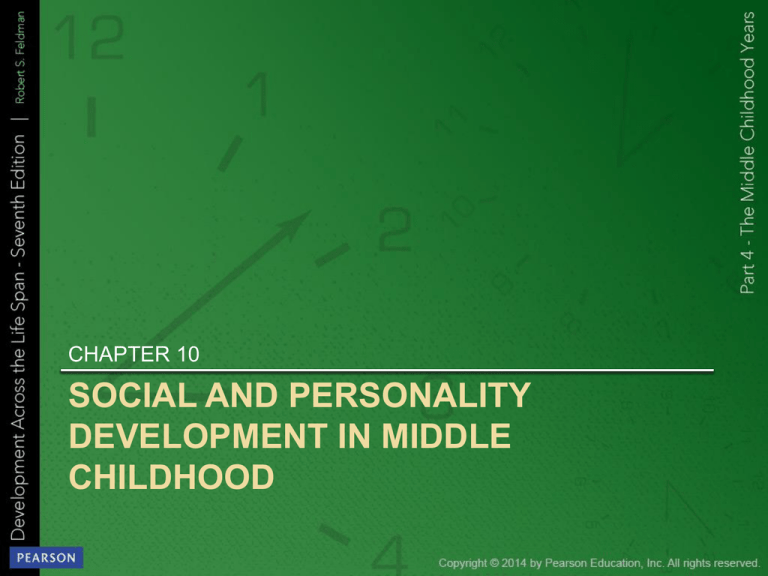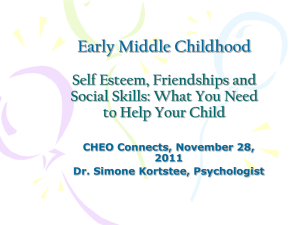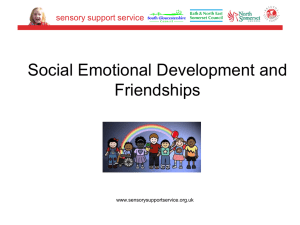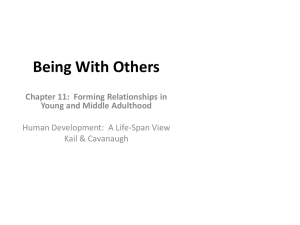children - srsiwok
advertisement

CHAPTER 10 SOCIAL AND PERSONALITY DEVELOPMENT IN MIDDLE CHILDHOOD Learning Objectives THE DEVELOPING SELF Who Am I? During middle childhood, children begin to view themselves: • Less in terms of external physical attributes • More in terms of psychological traits Psychosocial Development in Middle Childhood Success in the industry-versus-inferiority stage brings with it feelings of mastery and proficiency and a growing sense of competence • Industry = feelings of mastery and proficiency and a growing sense of competence • Inferiority = feelings of failure and inadequacy Erik Erikson's middle childhood • Encompasses the INDUSTRY-VERSUSINFERIORITY STAGE • Period from ages 6 to 12 years of age • Characterized by a focus on efforts to attain competence in meeting the challenges related to: – Parents – Peers – School – Other complexities of the modern world Understanding One's Self: A New Response to “Who Am I?” How do school-agers change? • Children realize they are good at some things and not so good at others • Self-concept and self-esteem continue to develop • Children's self-concepts become divided into personal and academic spheres Looking Inward: The Development of Self As children get older, their views of self become more differentiated, comprising several personal and academic spheres. What cognitive changes make this possible? (Source: Based on Shavelson, Hubner, & Stanton, 1976.) Social Comparison Children use social comparison to themselves to abilities, expertise, and opinions of others Festinger (1959) • When objective measures are absent children rely on social reality • How others act, think, feel, and view the world Sometimes… Children Make Downward Social Comparisons • With others who are: – Less competent – Less successful • To raise or protect their self-esteem Self-Esteem: Developing a Positive-or Negative-View of the Self Develops in important ways during middle childhood • Children increasingly compare themselves to others • Children are developing their own standards • For most children self-esteem improves in middle childhood Change and Stability in Self-Esteem Generally, overall self-esteem is high during middle childhood, but it begins to decline around the age of 12 • School transition • Chronically low self-esteem for some A Cycle of Low Self-Esteem Breaking the Cycle of Failure • Promoting development of self-esteem • Using authoritative child-rearing style Why do you think this style is recommended? Race and Self-Esteem Early research found that African Americans had lower self-esteem than whites • More recent research shows these early assumptions to be overstated – African Americans – Hispanic Americans – Asian Americans Why Does This Occur? Social Identity Theory • Members of a minority group accept negative views held by majority group only if they perceive little realistic possibility of changing power and status differences between groups Are Children of Immigrant Families Well Adjusted? • Tend to have equal or better grades than children with US born parents • Often more highly motivated to succeed and place greater value on education than do children in nonimmigrant families • Show similar levels of self-esteem to nonimmigrant children • Report feeling less popular and less in control of their lives Moral Development: Kohlberg • Proposes series of fixed stages in development of moral reasoning • Uses moral dilemmas to assess moral reasoning • Provides good account of moral judgment but not adequate at predicting moral behavior Kohlberg Stages Preconventional Morality (stages 1 & 2): • people follow unvarying rules based on rewards and punishments Conventional Morality (stages 3 & 4): Postconventional Morality (stages 5 & 6): • people approach problems in terms of their own position as good, responsible members of society • universal moral principles are invoked and considered broader than a particular society Kohlberg Criticisms • Based solely on observations of members of Western cultures • Theory initially based largely on data from males MORAL DEVELOPMENT IN GIRLS Carol Gilligan • Way boys and girls raised leads to differences in moral reasoning • Suggests Kohlberg's theory inadequate and places girls’ moral reasoning at lower level than boys’ Gilligan's Stages of Morality in Girls Review and Apply REVIEW • According to Erikson, children at this time are in the ____-versus-inferiority stage. • In the middle childhood years, children begin to use ____ ____and self-concepts based on ____ rather than physical characteristics. • During the middle childhood years, self-esteem is based on ____ with others and internal standards of ____; if self-esteem is ____, the result can be a cycle of failure. Review and Apply REVIEW • According to Kohlberg, ____ development proceeds from a concern with ____ and ____, through a focus on social conventions and rules, toward a sense of universal ____ principles. • Gilligan has suggested, however, that ____ may follow a somewhat different progression of ____ development. Review and Apply APPLY • Kohlberg and Gilligan each suggest there are three major levels of moral development. • Are any of their levels comparable? In which level of either theory do you think that the largest discrepancy between males and females would be observed? RELATIONSHIPS: BUILDING FRIENDSHIP IN MIDDLE CHILDHOOD Friends in Middle Childhood • Provide emotional support and help kids to handle stress • Teach children how to manage and control their emotions • Teach about communication with others • Foster intellectual growth • Allow children to practice relationship skills Damon's Stages of Friendship Stage 1 (ages 4-7 years) Children see friends as Children see people to friends as like share toys themselves and activities with Children do not take into account personal traits Damon's Stages of Friendship Stage 2 (ages 8-10 years) Children now Friends are begin to take viewed in terms Friendships are other's personal of kinds of based on qualities and mutual trust rewards they traits into provide consideration Damon's Stages of Friendship Stage 3 (ages 11-15 years) Friendships become based on intimacy and loyalty Friendships involve mutual disclosure and exclusivity Likes me…likes me not! INDIVIDUAL DIFFERENCES IN CHILDREN’S FRIENDSHIP King or Queen of the Hill…Status Hierarchies • Children's friendships show clear hierarchies in terms of status • Status is the evaluation of a role or person by other relevant members of a group High Status Children • Form friendships with high status children • More likely to form exclusive and desirable cliques • Tend to play with a greater number of children • Have greater access to resources such as games, toys, books, and information Popular Children Popular children Helpful and cooperative Good sense of humor Good emotional understanding Ask for help when necessary Not overly reliant on others Adaptive to social situations Social problem-solving skill competence Social Problem-Solving and Information Processing Low Status Children • Form friendships with other lower status children • Tend to play with a lower number of children than higher status children • Are more likely to play with younger or less popular children • Tend to follow the lead of higher status children Unpopular children Unpopular Children Lack social competence Immature or inappropriately silly Overly aggressive and overbearing Withdrawn or shy Unattractive, handicapped, obese, or slow academically Unpopular Children Lack of popularity may take two forms Neglected children • Receive relatively little attention from their peers in the form of either positive or negative interaction Rejected children • Are actively disliked and their peers may react to them in an obviously negative manner Teaching Social Competence Several programs teach children set of social skills that underlie general social competence • Before we review these, take a few minutes to visit with a classmate about what kind of program would best enhance social competence. • Report to the class. Schoolyard-and Cyber-Yard-Bullies At school • 160,000 U.S. schoolchildren stay home from school each day because they are afraid of being bullied • Almost 85 percent of girls and 80 percent of boys report experiencing some form of harassment in school at least once • Others encounter bullying on the Internet, which may be even more painful because often the bullying is done anonymously or may involve public postings Schoolyard-and Cyber-Yard-Bullies The bully • About 10 to 15 percent of students bully others at one time or another • About half of all bullies come from abusive homes • Bullies tend to watch more television containing violence, and they misbehave more at home and at school than do • nonbullies • When their bullying gets them into trouble, they may try to lie their way out of the situation, and they show little remorse for their victimization of others Bully School-bullied • Some 90 percent of middle-school students report being bullied at some point in their time at school, beginning as early as the preschool years • • • • Characteristics Loners who are fairly passive Often cry easily Lack the social skills that might otherwise defuse a bullying situation Reducing Bullying • One of the most effective ways to reduce the incidence of bullying is through school programs that enlist and involve students • For example, schools can train students to intervene when they see an instance of bullying, rather than watching passively • Empowering students to stand up for victims has been shown to reduce bullying significantly Gender and Friendships: The Sex Segregation of Middle Childhood Boyfriend, girlfriend…any friend? • Avoidance of opposite sex becomes very pronounced during middle childhood • Children's friendships are almost entirely sex-segregated • When sexes interact it is called “border work,” is often romantic, and helps emphasize clear boundaries between sexes Boys and Friendship Attempt to maintain and improve status in hierarchy • Restrictive play Strict dominance hierarchy Larger networks of friends than girls do Girls and Friendships Language is less confrontational and direct than boys’ Focus on one or two “best friends” of relatively equal status Can be confrontational with other girls not their friends Conflicts solved by compromise, ignoring situation, or giving in Are friendships color-blind? Cross-Race Friendships: Integration In and Out of the Classroom • Closest friendships largely with others of same race • Decline with age in number and depth of friendships outside own racial group Reducing Prejudice through Contact Between Groups Contact • Must occur in equal status settings • Enhanced through cooperative activities that are important to children • Must promote equality and disconfirm negative stereotypes Increasing Children's Social Competence Encourage social interaction Teach listening skills to children Make children aware that people display emotions and moods nonverbally Don't ask children to choose teams or groups publicly Teach conversational skills, including the importance of asking questions and self-disclosure Review and Apply REVIEW • Children's understanding of ____ changes from the sharing of ____ activities, through the consideration of ____ traits that can meet their needs, to a focus on ____ and loyalty. • Friendships in childhood display ____ hierarchies. Improvements in social ____ ____ and social information processing can lead to better ____ skills and greater popularity. • Boys and girls engage increasingly in same-sex friendships, with boys’ friendships involving ____ relationships and girls’ friendships characterized by ____ of girls with equal status. Review and Apply REVIEW • ____ friendships decrease in frequency as children age, but contact as peers among members of different races can promote ____ acceptance and appreciation. • Many children are the victims of ____ during their school years, but both victims and bullies can be ____ ways to reduce bullying. Review and Apply APPLY • Do you think the stages of friendship are a childhood phenomenon, or do adults’ friendships display similar stages? FAMILY AND SCHOOL: SHAPING CHILDREN’S BEHAVIOR IN MIDDLE CHILDHOOD Middle Childhood in the 21st Century In addition to other changes, children experience: • Increasing independence • Co-regulation with parents • Sibling relationships and rivalry Siblings Siblings • Sibling relationships are likely to endure across lifespan • Early relationships between siblings shape how children relate to others and choices made in later life What about children who have no siblings? • Only children are as well-adjusted as children with brothers and sisters • In some ways, only children are better-adjusted, often having higher self-esteem and stronger motivation to achieve When Both Parents Work Outside the Home: How Do Children Fare? In most cases, children fare quite well • When parents – Are loving – Are sensitive to their children's needs – Provide appropriate substitute care • Good adjustment of children relates to psychological adjustment of parents, especially mothers What do children do all day? Although the amount of time spent on some activities of children has remained constant over the years, the amount of time spent on others, such as playing and eating, has shown significant changes. What might account for these changes? (Source: Hofferth & Sandberg, 1998.) Self-Care Children Good or bad? Self-care children • Youngsters who let themselves into their homes after school and wait alone until their parents return from work • Consequences of being a latchkey child are not all harmful • Some children report being lonely • Some children develop a sense of independence and competence • Some research shows latchkey children have higher selfesteem because they are helping family The Consequences of Divorce • Only half of children in the U.S. will pass through childhood living with both parents each of whom has been married only once • School-age children tend to blame themselves for the breakup After the Break… Both children and parents may show several types of psychological maladjustments for 6 months to 2 years • Anxiety • Depression • Sleep disturbances • Phobias Rediscovering the Status Quo • After 18 months to 2 years, most children return to their predivorce psychological adjustment • Twice as many children of divorced parents require psychological counseling as do children from intact families • For some children, living in a home with unhappy marriage and which is high in conflict has stronger negative consequences than divorce Single Parent Families Single Parents Almost one-quarter of all children under 18 in the U.S. live with only one parent Numbers are higher for minority children • 60% of African-American children live in single parent homes • 35% of Hispanic children live in single parent homes Single Parents • In majority of cases, single parent is mother • Consequences of living in single parent home depend on: – Whether other parent ever lived at home – Economic status Multigenerational Families • Opportunity for rich experiences and conflicts • Greater among African Americans than among Caucasians • In some families, cultural norms tend to be highly supportive of grandparents taking an active role Yours, mine…ours • Blended families include remarried couple that has at least one stepchild living with them • Experts predict that by 2000, over 50 percent of children born in the last decade will be stepchildren • Living in blended family involves role ambiguity, in which roles and expectations are unclear Not all the news is bad!! • School-age children often adjust relatively smoothly to a blended family – Financial status of family improves – More people to share household chore – More social interaction and attention – But…not all children adjust well, especially if the new relationship is threatening Race and Family Life What do you know about…? •African-American families •Hispanic families •Asian-American families Poverty and Family Life Poor families • Fewer basic everyday resources • More disruptions in children's lives • Higher likelihood of stress Group Homes… • Term “orphanage” replaced by group home or residential treatment center – Group homes used for youngsters whose parents are no longer able to care for them adequately Anybody home? • The number of children in group care has growth over 50 percent • About three-quarters of children in group homes are victims of abuse and neglect • Most will eventually return home, however, one-fourth will be in group care throughout childhood Good or Bad? • Experts disagree on advantages and disadvantages of group care • Some see them as solution to unwed mothers who become dependent on welfare • Many who work in these homes say they cannot provide adequate love and support as family could • Group homes cost ten times as much as foster care or welfare Closing the Digital Divide: Some Unintended Consequences Digital divide • Distinction between technological haves and have nots • Unintended consequences • Non-educational use of computers • Much media use unmonitored by parents • Media use drops dramatically with parental monitoring School: The Academic Environment School Daze • During school year, more of day is spent in a classroom than anywhere else • Schools have large influence on children's lives How do children explain academic success and failure? Attributions • Children attempt to explain their behavior in one of three ways – Whether the cause is internal (dispositional) or external (situational) – Whether the cause is stable or unstable – Whether the cause is controllable or uncontrollable Attributional Confounds Race, ethnicity, and socioeconomic status have strong influences on attributions of success and failure • African-American children are less likely to attribute success to internal causes, feeling that prejudice and discrimination are to blame • Women tend to attribute failure to low ability and success to luck • In Asian countries, academic success is perceived as being caused by hard work Developmental Diversity: Explaining Asian Academic Success • US attribute school performance to stable, internal causes • Japan, China, and other East Asian countries see temporary, situational factors as cause of their performance Mothers’ Beliefs in Children's Ability Compared to mothers in Taiwan and Japan, U.S. mothers were less apt to believe that all children have the same degree of underlying, ability. Subjects responded using a 7-point scale, where 1 = strongly disagree and 7 = strongly agree. What are the implications of this finding for schooling in the United States? (Source: Stevenson & Lee, 1990.) Should Schools Teach Emotional Intelligence? Review and Apply REVIEW • Self-care children may develop ____ and enhanced ____ ____ from their experience. • How divorce affects children depends on such factors as ____ circumstances and the comparative levels of tension in the family ____ and ____ the divorce. • The effects of being raised in a ____ ____ household depend on financial circumstances, the amount of parent–child interaction, and the level of tension in the family. Review and Apply REVIEW • ____ patterns differ along individual, cultural, and gender dimensions. • ____ ____, the skills that underlie the accurate assessment, evaluation, expression, and regulation of emotions, is becoming accepted as an important aspect of ____ ____. Review and Apply APPLY • Politicians often speak of “family values.” How does this term relate to the diverse family situations covered in this chapter, including divorced parents, single parents, blended families, working parents, self-care children, abusive families, and group care? EPILOGUE Return to the prologue—about Matt Donner's social struggles—and answer the following questions: •Why do you think Matt seems to blame himself for being the victim of bullies? •What might be the motivation for other kids to bully Matt? How might it make them feel about themselves? •If a school guidance counselor wanted to help Matt adjust to his new school and make friends, what advice could she give him? EPILOGUE • Why might Matt's parents be so in the dark about what was going on with their son at his new school? Why do you think Matt wanted to keep it that way?









